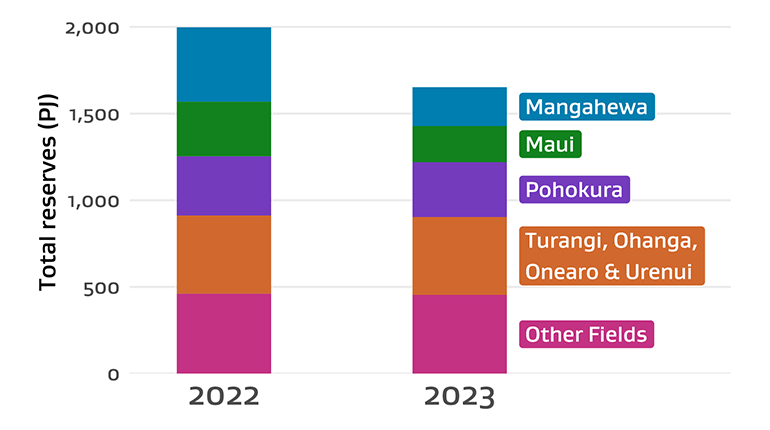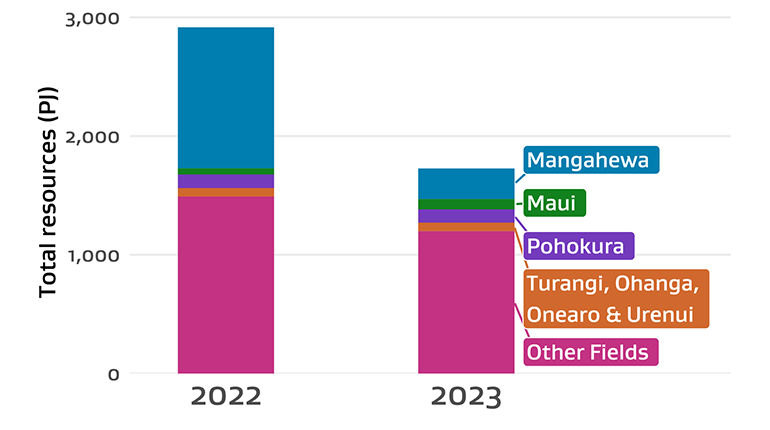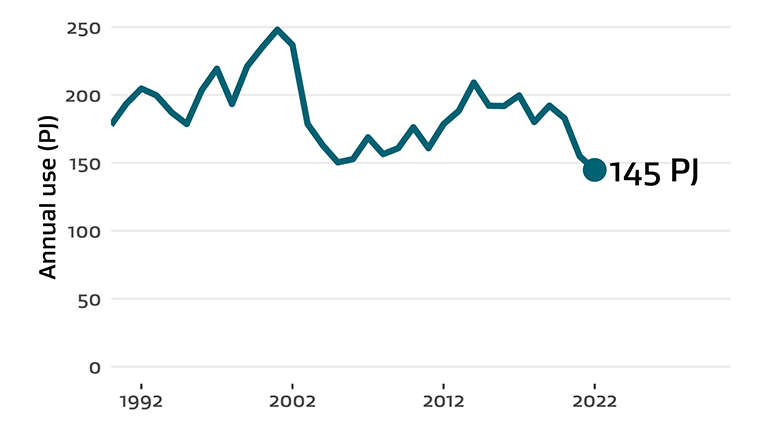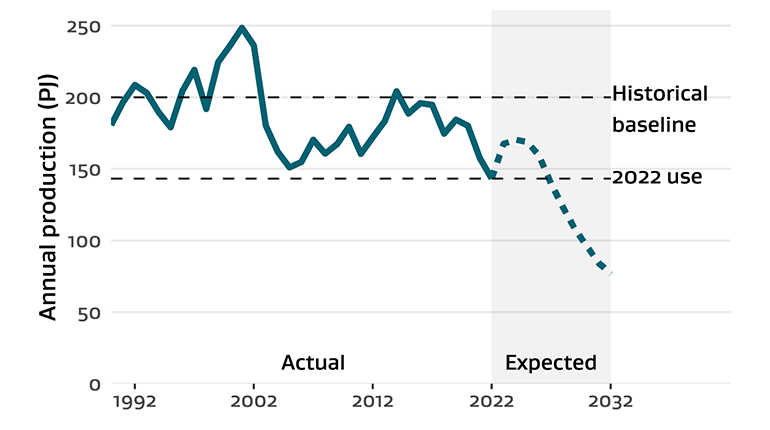Natural gas
New Zealand’s natural gas fields are concentrated around and off the coast of the Taranaki region. All natural gas produced in New Zealand is used in New Zealand.
On this page
The largest user of natural gas in New Zealand is Methanex, which uses natural gas to produce methanol. While some large users have direct connections to natural gas fields, most users draw natural gas from a network of pipes maintained by Firstgas. As this network does not extend to the South Island, natural gas is exclusively used in the North Island.
A subsidiary of Firstgas, Flex Gas, operates the New Zealand’s only natural gas storage facility at Ahuroa.
Natural gas at a glance
Net indigenous production
Natural gas used for electricity generation
Natural gas used for cogeneration
Non-energy use
Consumption
- Residential consumption makes up 5% of natural gas use
- Natural gas production is expected to peak in 2024
- There has been a 17% decrease in Proven plus Probable reserves (2P).
Less natural gas is available to produce than previously thought
Proven plus Probable (2P) reserves represent the amount of natural gas that field operators expect to extract from the ground based on current technological and economic conditions.
Total 2P Reserves were revised down by 332 PJ (17%) between January 2022 and January 2023 (Figure E.1). Most of these revisions occurred at the Mangahewa field (down 205 PJ or 48%) and the Maui field (down 106 PJ or 34%).
There was 143 PJ of natural gas produced in 2022. This means that 43% of the change in reserves was due to natural gas being extracted in 2022 and 57% of the change was a result of fields revising how much natural gas there was in the field.
Figure E.1 2P Remaining Reserves by major field, 2022 versus 2023

Text description of figure E.1
Contingent Resources (2C) provide estimates of quantities of natural gas in a field that may be extracted, but only under different economic or technological conditions to what we have today. It is likely that producers will extract some contingent resources in future, but not all.
2C Contingent Resources have decreased by 1,188 PJ (41%) between January 2022 and January 2023 (Figure E.2). This drop came almost entirely from the Mangahewa field (down 930PJ or 78 per cent) and Kapuni field (down 294 PJ or 36 per cent). The largest increase in 2C Contingent Resources came from the Maui field, which increased 35 PJ (up 70%).
This shows that the drop in natural gas reserves is not only because producers are less sure that they can economically extract the natural gas in their fields, but also because they believe there is less natural gas available in those fields.
Figure E.2 2C Contingent Resources by major field, 2022 versus 2023

Text description of figure E.2
Our use of natural gas will need to decline in coming years
Methanex mothballing its Waitara Valley facility in 2021. Chemical use (including non-energy use) fell by 4.77 PJ (7.5%) between 2021 and 2022, and has fallen 26.6 PJ (31%) since 2019.
In the past, the largest use of natural gas in New Zealand has been for chemical production such as producing methanol and urea, and refining oil (Table E.1). Other major users of natural gas in recent years are the food processing and electricity generation sectors.
| Sector PJ | 2018 | 2019 | 2020 | 2021 | 2022 |
| Chemical production (including non-energy use) | 77.0 | 85.6 | 77.8 | 63.8 | 59.0 |
| Electricity generation (including cogeneration) | 49.2 | 49.6 | 53.7 | 42.9 | 41.9 |
| Food processing | 18.3 | 21.7 | 18.7 | 16.3 | 15.4 |
| Other consumption | 21.0 | 21.1 | 18.7 | 16.3 | 15.4 |
| Residential | 6.8 | 6.8 | 7.2 | 7.2 | 6.8 |
A common method used to understand the amount of natural gas left in New Zealand is to compare the total amount remaining to the amount used in a typical year. This gives us an estimate of how many years we could keep using natural gas at our present rate.
In the past, the baseline for a ‘typical year’ of usage has been 200 PJ a year. But this figure does not reflect current market conditions. The last year when total annual usage was more than 200 PJ was 2014 (Figure E.3).
Figure E.3 New Zealand’s total annual usage of natural gas from 2013 to 2022

Text description of figure E.3
Alternatively, we could look at the remaining natural gas is to compare current use with expected future production year-by-year (Figure E.4).
Figure E.4 Actual and expected natural gas production in New Zealand from 1990 to 2032

Text description of figure E.4
Based on reporting by natural gas producers, New Zealand’s annual production from 2P Reserves is expected to peak at 170 PJ in 2024. It is then expected to start a sustained decline, falling below our total use in 2022 of 145 PJ by 2027, and decreasing to 77 PJ by 2032. These production profiles do not include any additions that may come from 2C Contingent Resources that producers may decide to extract.
New Zealand will need to invest in natural gas producing reserves and upgrading existing resources at natural gas fields to sustain current levels of use. Alternatively natural gas use may be reduced by replacing natural gas with electricity or renewable alternatives.
The Government is working to develop a Gas Transition Plan to support the gas industry to reduce emissions in such a way that ensures energy remains accessible, reliable and affordable to New Zealanders. For more information about the Gas Transition Plan, see:

